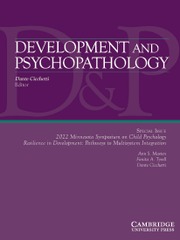Crossref Citations
This article has been cited by the following publications. This list is generated based on data provided by
Crossref.
Ostrander, John Francis
and
Ferrucci, Susana
2007.
Co-occurring Disorders, Emotion/Mood Literacy, and Emotion/Mood Regulation.
International Journal of Mental Health and Addiction,
Vol. 5,
Issue. 3,
p.
195.
Singh, Manpreet K
and
Chang, Kiki D
2007.
Impact of Bipolar Disorder on Selected Areas of Pediatric Development: A Research Update.
Pediatric Health,
Vol. 1,
Issue. 2,
p.
199.
Cahill, Catherine
Hanstock, Tanya
Jairam, Rajeev
Hazell, Philip
Walter, Garry
and
Malhi, Gin S.
2007.
Comparison of Diagnostic Guidelines for Juvenile Bipolar Disorder.
Australian & New Zealand Journal of Psychiatry,
Vol. 41,
Issue. 6,
p.
479.
Braga, Audrey Regina Magalhães
Kunzler, Lia Silvia
and
Hua, Feng Yu
2008.
Transtorno de humor bipolar: diversas apresentações de uma mesma doença.
Revista de Psiquiatria do Rio Grande do Sul,
Vol. 30,
Issue. 1,
p.
77.
West, Amy E.
Schenkel, Lindsay S.
and
Pavuluri, Mani N.
2008.
Early childhood temperament in Pediatric bipolar disorder and attention deficit hyperactivity disorder.
Journal of Clinical Psychology,
Vol. 64,
Issue. 4,
p.
402.
Phillips, M L
Ladouceur, C D
and
Drevets, W C
2008.
A neural model of voluntary and automatic emotion regulation: implications for understanding the pathophysiology and neurodevelopment of bipolar disorder.
Molecular Psychiatry,
Vol. 13,
Issue. 9,
p.
833.
Joseph, Megan F.
Frazier, Thomas W.
Youngstrom, Eric A.
and
Soares, Jair C.
2008.
A Quantitative and Qualitative Review of Neurocognitive Performance in Pediatric Bipolar Disorder.
Journal of Child and Adolescent Psychopharmacology,
Vol. 18,
Issue. 6,
p.
595.
Ayer, Lynsay
Althoff, Robert
Ivanova, Masha
Rettew, David
Waxler, Ellen
Sulman, Julie
and
Hudziak, James
2009.
Child Behavior Checklist Juvenile Bipolar Disorder (CBCL‐JBD) and CBCL Posttraumatic Stress Problems (CBCL‐PTSP) scales are measures of a single dysregulatory syndrome.
Journal of Child Psychology and Psychiatry,
Vol. 50,
Issue. 10,
p.
1291.
Youngstrom, Eric A.
2009.
Definitional issues in bipolar disorder across the life cycle..
Clinical Psychology: Science and Practice,
Vol. 16,
Issue. 2,
p.
140.
Masten, Carrie L.
Eisenberger, Naomi I.
Borofsky, Larissa A.
Pfeifer, Jennifer H.
McNealy, Kristin
Mazziotta, John C.
and
Dapretto, Mirella
2009.
Neural correlates of social exclusion during adolescence: understanding the distress of peer rejection.
Social Cognitive and Affective Neuroscience,
Vol. 4,
Issue. 2,
p.
143.
Dickstein, Daniel P.
Brazel, Alison C.
Goldberg, Lisa D.
and
Hunt, Jeffrey I.
2009.
Affect Regulation in Pediatric Bipolar Disorder.
Child and Adolescent Psychiatric Clinics of North America,
Vol. 18,
Issue. 2,
p.
405.
McClure-Tone, Erin B.
2009.
Socioemotional functioning in bipolar disorder versus typical development: Behavioral and neural differences..
Clinical Psychology: Science and Practice,
Vol. 16,
Issue. 2,
p.
98.
Koenigsberg, Harold W.
Siever, Larry J.
Lee, Hedok
Pizzarello, Scott
New, Antonia S.
Goodman, Marianne
Cheng, Hu
Flory, Janine
and
Prohovnik, Isak
2009.
Neural correlates of emotion processing in borderline personality disorder.
Psychiatry Research: Neuroimaging,
Vol. 172,
Issue. 3,
p.
192.
Wakschlag, Lauren S.
Tolan, Patrick H.
and
Leventhal, Bennett L.
2010.
Research Review: ‘Ain’t misbehavin’: Towards a developmentally‐specified nosology for preschool disruptive behavior.
Journal of Child Psychology and Psychiatry,
Vol. 51,
Issue. 1,
p.
3.
Rosen, Heather R.
and
Rich, Brendan A.
2010.
Neurocognitive Correlates of Emotional Stimulus Processing in Pediatric Bipolar Disorder: A Review.
Postgraduate Medicine,
Vol. 122,
Issue. 4,
p.
94.
Ladouceur, Cecile D.
Farchione, Tiffany
Diwadkar, Vaibhav
Pruitt, Patrick
Radwan, Jacqueline
Axelson, David A.
Birmaher, Boris
and
Phillips, Mary L.
2011.
Differential Patterns of Abnormal Activity and Connectivity in the Amygdala–Prefrontal Circuitry in Bipolar-I and Bipolar-NOS Youth.
Journal of the American Academy of Child & Adolescent Psychiatry,
Vol. 50,
Issue. 12,
p.
1275.
Masten, Carrie L.
Colich, Natalie L.
Rudie, Jeffrey D.
Bookheimer, Susan Y.
Eisenberger, Naomi I.
and
Dapretto, Mirella
2011.
An fMRI investigation of responses to peer rejection in adolescents with autism spectrum disorders.
Developmental Cognitive Neuroscience,
Vol. 1,
Issue. 3,
p.
260.
Hilt, L.M.
Hanson, J.L.
and
Pollak, S.D.
2011.
Encyclopedia of Adolescence.
p.
160.
Bitter, Samantha M.
Mills, Neil P.
Adler, Caleb M.
Strakowski, Stephen M.
and
DelBello, Melissa P.
2011.
Progression of Amygdala Volumetric Abnormalities in Adolescents After Their First Manic Episode.
Journal of the American Academy of Child & Adolescent Psychiatry,
Vol. 50,
Issue. 10,
p.
1017.
Dickstein, Daniel P.
and
Castellanos, F. Xavier
2011.
Behavioral Neuroscience of Attention Deficit Hyperactivity Disorder and Its Treatment.
Vol. 9,
Issue. ,
p.
219.


